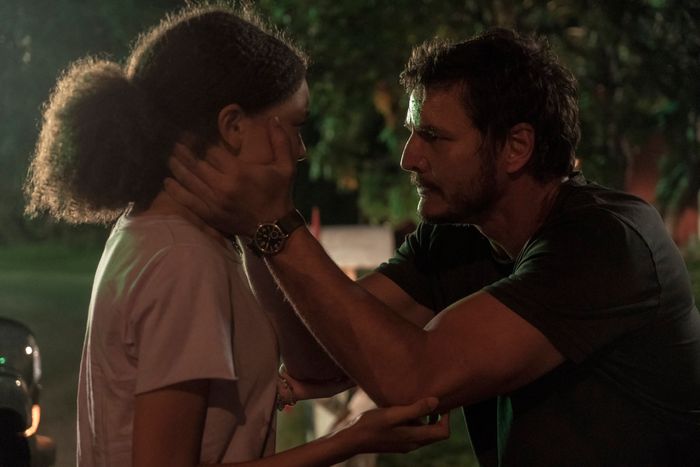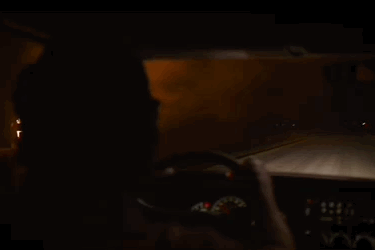
The Last of Us takes its time revving up. The HBO video-game adaptation opens on a 1960s TV interview program (hosted by Bighead!) featuring two epidemiologists discussing the possible end of humanity via disease. John Hannah plays the more portentous of the duo, laying out the mechanics of what will eventually drive the apocalypse in this universe: mind-controlling fungus, previously a phenomenon contained to the insect world, pushed by climate change to evolve such that it makes the jump into human beings. As he speaks of how the infection would ravage billions, the camera repeatedly cuts to the audience; faces blank, heightened, a mass. The scene is brief, but the tone is set.
That opening scene is specific to the TV show, and it immediately forecasts an intent to move this story at its own pace. As someone long familiar with the source material, the choice is exciting: the HBO version places a premium on leaving room to breathe. The narrative patiently settles into a pre-apocalypse world, introducing Pedro Pascal’s Joel Miller, his daughter Sarah (Nico Parker), and his younger brother Tommy (Gabriel Luna) on Joel’s birthday, as Sarah embarks on a quest to get his old watch fixed. You get the drift of Joel’s situation fairly briskly: single parent, tight relationship with Sarah, she’s a good kid. It’ll be another ten minutes of show before shit hits the fan, and when it does, you’re fully baked into their family and the effect of catastrophic implosion and chaos hits more clearly and holistically.
This wasn’t necessarily the case in the source material. The original video game arrived in 2013, a moment when big-budget AAA studios were deep into a yearslong effort to aesthetically replicate a sense of cinematic spectacle. In many ways, this ran parallel to a similar movement in television; The Walking Dead had premiered three years before, and HBO’s own Game of Thrones followed a year after that. Indeed, what made the original Last of Us particularly interesting was how it seemed to emulate prestige television more than anything else: Besides its visual realism, there was an episodic nature to the grim, heady story, which usually takes around 15 hours of gameplay to complete.
However, back in 2013, the game was still doing its best with the tools it had within the context of its medium. Its opening sequence had to do more economical narrative work in order to get you into play as soon as possible, opening just hours before the outbreak with a scene that also appears in the show — albeit 15 minutes in — in which Sarah gifts Joel that watch for his birthday. This cut scene does some expository labor, but the work of grounding you in the world chiefly happens through environmental storytelling, which is something that isn’t entirely possible with television or movies. (Though one could possibly argue Alfonso Cuarón’s Children of Men, which does a ton of world-building through background elements that the camera often glides by, came quite close.) The very first character you control is Sarah, whom you guide through a splendid sequence that evokes the feeling of being a child alone at home. Details like soccer trophies or a weirdly placed Stairmaster around the house communicate to you, the player, the circumstances of their lives — but it’s dark, Joel isn’t around, and the world is ending.
The game and the HBO show converge when the three Millers get into the car. For those with a strong attachment to the original work, the last decade was essentially building up to this moment, and what transpires in the TV adaptation is something close to a shot-for-shot remake. The camera assumes a view from the back seat, mimicking Sarah’s perspective as the family tries to get out of Dodge. (In the game, you control where Sarah is looking, meaning you can miss whole images like their neighbor’s burning home or an overrun hospital.) Many lines from the game are preserved (“They have a kid, Joel.” “So do we.”), while distinct tweaks have been made to further enhance the onscreen drama. The plane crash, for example, is an invention for the show; in the video game, Sarah and Joel are knocked out when another car slams into theirs.


The HBO remake of the outbreak sequence is striking in how it fully realizes what the original work was simulating. Playing the game, you can feel The Last of Us strain to use its elemental tools to achieve the kind of cinematic storytelling it’s going for, even as it’s ultimately successful. While you control Joel navigating the chaotic streets, Sarah in tow, it’s not uncommon to spot the seams of the technology of the time: Tommy’s pathfinding blocking you in strange ways, the artificially intelligent crowd not quite swarming in a manner that tracks organically. (The remake with more modern tech, released last fall, is only somewhat better.) Since this is a game, it’s also a sequence with a fail state. If you don’t run fast enough, Joel gets bitten, the screen blacks out, and you have to begin again. This cultivates a sense of urgency in the player, but it opens up the possibility of some meaningful cost to the narrative momentum. Such a trade-off is endemic to video games.
It’s really something to see a prestige TV show literally translate a scene from a game that was, in its own way, already emulating a prestige TV show. The promise of an adaptation — and this adaptation in particular — is the possibility of expansion: to more deeply explore, or perhaps even subvert, the narrative themes of the widely beloved story that powered this wildly successful video game. It’s a dramatic act of imagining, taking an original text and finding new life. But as the first half of HBO’s spectacular pilot episode shows, you still gotta play the hits.
More From This Series
- The Last of Us Spawns a Teaser
- So … What Will the 2025 Emmys Look Like?
- 15 Inanimate Objects I Can’t Look at Without Crying Thanks to TV


